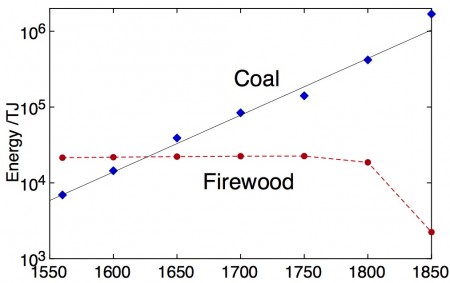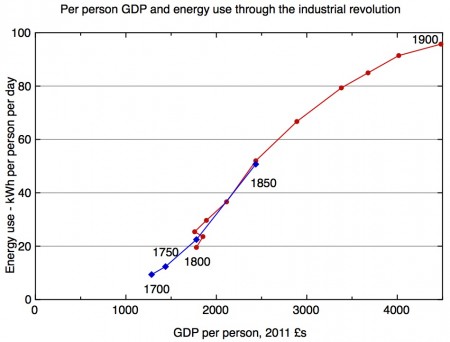Was the industrial revolution an energy revolution, in which the energy constraints of a traditional economy based on the power of the sun were broken by the discovery and exploitation of fossil fuel? Or was it an ideological revolution, in which the power of free thinking and free markets unlocked human ingenuity to power a growth in prosperity without limits? Those symbols of the industrial revolution – the steam engine, the coke-fuelled blast furnace – suggest the former, but the trend now amongst some economic historians is to downplay the role of coal and steam. What I think is correct is that the industrial revolution had already gathered much momentum before the steam engine made a significant impact. But coal was central to driving that early momentum; its use was already growing rapidly, but the dominant use of that coal was as a source of heat energy in a whole variety of industrial processes, not as a source of mechanical power. The foundations of the industrial revolution were laid in the diversity and productivity of those industries propelled by coal-fuelled process heat: the steam engine was the last thing that coal did for the industrial revolution, not the first.
What’s apparent, and perhaps surprising, from a plot of the relative contributions of coal and firewood to England’s energy economy, is how early in history the transition from biomass to fossil fuels took place. Using estimates quoted by Wrigley (a compelling advocate of the energy revolution position), we see that coal use in England grew roughly exponentially (with an annual growth rate of around 1.7%) between 1560 and 1800. The crossover between firewood and coal happened in the early seventeenth century, a date which is by world standards very early – for the world as a whole, Smil estimates this crossover only happened in the late 19th century.
Estimated consumption of coal and biomass fuels in England and Wales; data from Wrigley – Energy and the English Industrial Revolution.
So why did coal use become so important so early in England? Quite simply, because there was a lot of it about, and it was easy to extract. Surface coal deposits were very widespread in England, Wales and Scotland, and almost every city associated with the industrial revolution was either located directly on top of such a coal field or within a few miles of one. In Glasgow, Edinburgh, Neath and Aberavon, Manchester, Leeds, Bristol, Sheffield, the Potteries, Ironbridge and the Severn Gorge, Birmingham and the Black Country coal was available, in early modern times, simply by digging shallow pits in the ground. The one exception to this was London itself – but London was served by rich coal-fields in Newcastle, from which coal could be loaded straight onto ships in the Tyne, to be carried in bulk down to the Thames. With the inadequate communications of early modern England a bulky commodity like coal could not economically be carried far overland – a carriage of a few miles by cart or packhorse was the most that was usually realistic. So the users of the coal needed to be on, or very close to, the surface coalfields themselves.
The industries that grew on the back of this easily accessible coal were diverse and central to the growth in economic diversity and technological sophistication of the early modern economy. Clusters of metal working grew up in Sheffield and the West Midlands, their forges fuelled by local coal. An early chemicals industry, boiling soap, evaporating brine and making the industrial chemicals the growing textiles industry needed, like iron sulphate and alum, used prodigious quantities of fuel. The production of consumer goods became centralised and industrialised. Beer was one of the first industrially produced foodstuffs, extensively using coal first in its boiling operations, then, after the invention of coking in the mid-17th century, for malt drying. Centres of mass-produced ceramics grew up around Stoke-on-Trent and north Derbyshire, their kilns fuelled by local coal. And underlying the growth in urbanisation and the building of infrastructure was lime burning for mortar (lime was also very important in the agricultural improvements of the day, applied in large quantities to sweeten acid soils), brick and tile making, glass making and iron nail production, all consuming coal in large quantities. Most of these industries were already well established, growing fast, and consuming increasing amounts of coal, by the end of the 17th century. Perhaps the last of the process industries to be transformed by coal were in metallurgy, where the use of coal to replace charcoal in iron-making required the technological development of coke-making, as first invented for malt-drying.
So, whence does the scepticism about the role of coal in the industrial revolution arise? My impression is that the sceptics look too late in time, missing the importance of the 17th and 18th century efflorescence of the process industries, and give too much attention to the steam engine. Joel Mokyr, for example, in his brilliant, erudite, and otherwise convincing book “The Enlightened Economy”, says “If nobody had possessed coal, Britain would have had to have found alternative sources of energy, and surely water and wind power would have played a bigger role. The presence of fossil fuels thus had significant economic and environment consequences, but did not “cause” economic growth. Ingenuity did.” Clearly, fossil fuels didn’t by themselves cause economic growth, but I think the evidence is clear that their easy accessibility was a necessary condition for it. It was indeed ingenuity that devised and improved all those industrial processes that depended on coal, but if the coal hadn’t been there that ingenuity would have had no outlet.
It’s worth returning to the question of the steam engine. This was clearly an enormously important development for the development of industry in the 19th century, but it was much less significant in the 18th century. Savery’s engine was a toy of no economic significance (though it is interesting and important in what it tells us about the route from the high science of air pumps to the technology of engines), while Newcomen’s engine was a single purpose technology whose main early effect was to help extract more coal – therefore it was an effect of increasing demand for coal, not a cause of it (its use in the Cornish tin mines is an exception, though an important one for the improvement of the technology thanks to Smeaton’s engineering brilliance). James Watt’s late 18th century development of the separate condenser did lay the foundations for the steam engine’s transformational effect in the 19th century, but Smil quotes an estimate that by 1800 only 1/10 of England’s coal output was supplying steam engines.
The most sustained piece of argument against the importance of coal is in an article by Clark and Jacks, Coal and the Industrial Revolution, 1700–1869 (PDF). This uses a sophisticated and ingenious analysis to answer, with great rigour, a question which is entirely irrelevant for the problem at hand. Their analysis of the British coal industry demonstrates that there was no growth in total factor productivity in that industry through the industrial revolution. This is entirely plausible – there surely was some technological advance in the industry over that time, but this may well have been offset by diminishing returns due to the exhaustion of the easiest to reach reserves. And we know that coal mining has long proved quite resistant to full mechanisation in its underground operations – hand-cutting of coal was still taking place at least until the mid-20th century, the last horse gin was in use until 1943, and pit ponies were still being used in the 1990s. But all of this is completely irrelevant to the question of how important coal was to the industrial revolution – for that, it’s not the productivity of coal mining itself that’s important, it’s the effect the availability of coal has on the productivity of other industries, and on the creation of the infrastructure of the industrial revolution. That effect was transformational over a very wide variety of areas of the economy.
A secondary argument made by Clark and Jacks is that, even in the absence of coal, England’s energy needs in the mid-19th century could have been met by the importation of firewood from the Baltic . That may well be true at that particular point in time, but that’s because by then England was already a rich nation and an energy intensive economy – its abundance of coal had by then already done its work through that all important period of energy and GDP takeoff in the 18th century. The close coupling between the growth in GDP caused by the industrial revolution and the growth in energy consumption from coal is shown in my second plot. England became a rich nation because it was able to develop many energy intensive industries, it didn’t use a lot of energy because it was wealthy.
The growth in per capita GDP and energy consumption through the British industrial revolution. GDP and population data from Hills, S, Thomas, R and Dimsdale, N (2015) “Three Centuries of Data – Version 2.2”, Bank of England. Energy data (red points, 10 year interval) from Fouquet and Pearson (A thousand years of energy use in the UK), (blue points, 50 year interval) from Wrigley.
This is an argument about history, but it is centrally relevant to the problems of today. Having developed an economy which is existentially dependent on fossil fuels, we now realise that this has already caused a very substantial rise in the carbon dioxide composition of the atmosphere, which has already changed the earth’s climate. This climate change will continue, with uncertain but profoundly worrying consequences (see my earlier post Climate change: what do we know for sure, and what is less certain?). Understanding how we became dependent on fossil fuels will help us learn how to break that dependency. Arguments which downplay the importance of coal in the industrial revolution, by overplaying the significance of unaided ingenuity and free market ideology in that historical transition, encourage complacency about the difficulties of the transition we now face in moving to a sustainable energy economy.
Sources: this post was inspired by an exchange on the blog of the economic historian Anton Howes. A great overview of the world’s transition to a fossil fuel based economy, and the prospects for a future transition to a sustainable, solar-powered energy economy can be found in my colleague Tony Ryan’s book (with Steve McKevitt), The Solar Revolution. Vaclav Smil’s Energy in Nature and Society is outstanding for its planetary scale context. Wrigley’s Energy and the English Industrial Revolution presents the case that the industrial revolution was fundamentally an energy revolution, while Mokyr’s The Enlightened Economy emphasises its cultural and ideological roots. Hatcher’s first volume of the History of the British Coal Industry has much detail about coal mining and the industries that depended on it before 1700.

